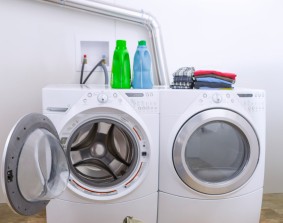You use your bath towels when you are at your cleanest. So it stands to reason that they should never get dirty, right? Yet that stiffness and faint smell they develop after a few weeks seem to tell a different story. Same thing with top-load washing machines: You would think they clean themselves every time they clean your clothes, but a little extra maintenance goes a long way.
Especially with new high-efficiency washers, not all cycles fill the basket all the way up with water. That means some areas are seldom submerged. Also, there is a difference between a clean appearance and a sanitary environment. Allergens and bacteria can grow even when it looks spotless. Why would you spend hundreds of dollars getting the best appliance to clean your clothes, and then keep it from working at its peak performance? For best results, your washing machine should be cleaned in one- to three-month intervals.
We put together five tips to help you keep your washer – and thus your laundry – the cleanest it can be:
Many new top-load washing machines have a sanitize cycle. These come in two types. If your model has an onboard heater, it can get hot enough to sanitize itself without bleach or other harsh chemicals. If no onboard heater is present, few high-efficiency washers get hot enough to do a stand-alone sanitize, so the cycle will require bleach or special washing-machine sanitizer tablets that are sold separately. Read your instruction manual and follow it carefully when sanitizing your washer, and never put laundry in your washing machine while it is sanitizing, as it could damage the clothes.
If your top-load washing machine doesn’t have its own sanitize cycle, you can simulate one by tuning it to its hottest setting (check the user manual if you are unsure which one this is) and the largest load setting. When it is full, add about a quart of white vinegar and 4 ounces of baking soda. (If you don’t have vinegar on hand, use 2 cups of lemon juice instead.) This mixture will not only remove dirt and grime, but also hard-water deposits. Once the basket has spun enough to dissolve the baking soda, pause the machine and let it sit for at least a half-hour. Then restart the machine and let it finish its cycle. If you have a spin-and-drain cycle, select this setting to spin out any grime that might have been loosened. When the washer is empty, wipe down all surfaces with a solution of hot water and white vinegar.
If your washing machine has dispensers for detergent, bleach or fabric softener, these dispensers or the compartments that hold them can be a magnet for gunk and grime. Take a hot wash rag to these areas as well. An old toothbrush can be a handy tool to reach difficult nooks and crannies.
Now that your top-loader is ready for more loads, make sure you are using the correct detergent for its type. High-efficiency washing machines should always be run with high-efficiency detergent. Otherwise, suds can overrun the washer and moisture can end up where it shouldn’t, eventually growing mildew and smelling dank. If you accidentally use low-efficiency detergent or just too much detergent and notice there are still suds in the washer, run an extra rinse cycle to clean it out.
If your washer basket has developed stains or discoloring, vinegar and baking soda may not be enough to thoroughly clean it out. Follow the same steps but with a quart of chlorine bleach instead. Remember not to include clothing in this cycle!
It doesn’t make sense to spend top dollar for a premium cleaning machine and then not clean the machine. Follow these steps, and your new top-load washer will decontaminate your wardrobe for years to come.
Source: http://top-load-washing-machine-review.toptenreviews.com/5-tips-for-cleaning-your-top-load-washing-machine.html
